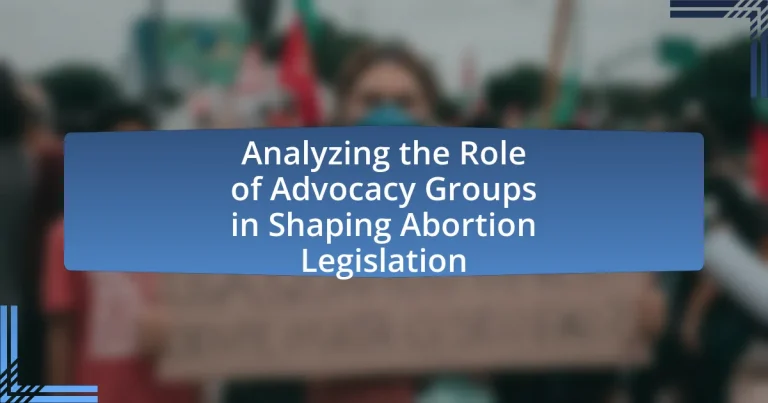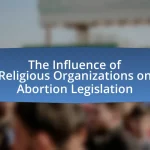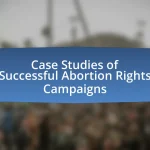Advocacy groups play a pivotal role in shaping abortion legislation by influencing public opinion, lobbying lawmakers, and mobilizing grassroots support. This article analyzes the strategies employed by both pro-choice and pro-life organizations, highlighting their impact on legislative outcomes and public attitudes towards abortion. It examines the historical context of advocacy efforts, the methods used to engage with policymakers, and the challenges faced by these groups in promoting their agendas. Additionally, the article discusses the long-term effects of advocacy on abortion rights and offers best practices for enhancing collaboration and engagement within diverse communities.
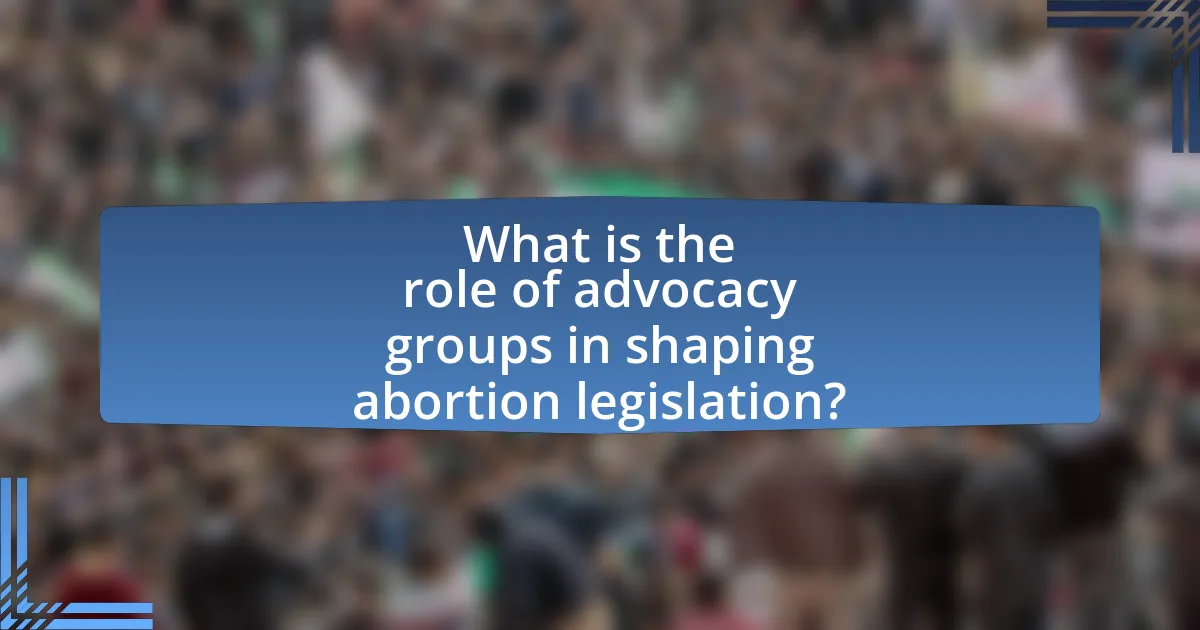
What is the role of advocacy groups in shaping abortion legislation?
Advocacy groups play a crucial role in shaping abortion legislation by influencing public opinion, lobbying lawmakers, and mobilizing grassroots support. These organizations, such as Planned Parenthood and the National Right to Life Committee, engage in campaigns that educate the public about their positions on abortion, thereby swaying voter sentiment and legislative priorities. For instance, according to a 2020 report by the Guttmacher Institute, states with active advocacy groups saw a higher likelihood of introducing or defeating abortion-related bills, demonstrating their direct impact on legislative outcomes. Additionally, these groups often provide legal resources and support for litigation that challenges restrictive laws, further shaping the legal landscape surrounding abortion rights.
How do advocacy groups influence public opinion on abortion?
Advocacy groups influence public opinion on abortion primarily through strategic communication, grassroots mobilization, and targeted campaigns. These organizations utilize social media, traditional media, and public events to disseminate their messages, framing abortion in ways that resonate with specific audiences. For instance, studies show that pro-choice groups often highlight personal stories and health implications, while pro-life groups emphasize moral and ethical considerations. Research indicates that exposure to advocacy messaging can significantly shift public attitudes; a 2019 study published in the Journal of Health Politics, Policy and Law found that individuals who engaged with pro-choice content were more likely to support abortion rights. Thus, advocacy groups play a crucial role in shaping perceptions and influencing legislative outcomes related to abortion.
What strategies do advocacy groups use to mobilize support?
Advocacy groups mobilize support through strategies such as grassroots organizing, coalition building, and targeted communication campaigns. Grassroots organizing involves engaging community members to participate in activism, which can include rallies, petitions, and local meetings, effectively increasing visibility and support for their cause. Coalition building allows advocacy groups to unite with other organizations, amplifying their reach and resources, as seen in the collaboration between various reproductive rights organizations to influence legislation. Targeted communication campaigns utilize social media, traditional media, and direct outreach to inform and persuade the public, exemplified by campaigns that highlight personal stories and data to evoke emotional responses and drive action. These strategies collectively enhance the ability of advocacy groups to influence public opinion and legislative outcomes regarding abortion legislation.
How does public opinion impact legislative outcomes?
Public opinion significantly impacts legislative outcomes by influencing lawmakers’ decisions and priorities. When a majority of constituents express strong views on an issue, such as abortion, legislators often feel compelled to align their actions with public sentiment to secure votes and maintain support. For instance, surveys indicate that in the United States, public support for abortion rights has fluctuated, affecting legislative measures at both state and federal levels. In 2021, a Gallup poll showed that 58% of Americans identified as pro-choice, which prompted several states to introduce or uphold laws protecting abortion access. This correlation between public opinion and legislative action demonstrates how elected officials respond to the prevailing attitudes of their constituents to ensure electoral viability.
What types of advocacy groups exist in the abortion debate?
In the abortion debate, there are primarily two types of advocacy groups: pro-choice groups and pro-life groups. Pro-choice groups advocate for the right to access abortion services and reproductive health care, emphasizing women’s autonomy and decision-making power. Organizations such as Planned Parenthood and the National Abortion Federation represent this perspective, often citing legal precedents like Roe v. Wade to support their stance. Conversely, pro-life groups oppose abortion, advocating for the rights of the unborn and promoting alternatives to abortion, such as adoption. Notable organizations in this category include the National Right to Life Committee and Americans United for Life, which often reference moral and ethical arguments against abortion. These advocacy groups play a crucial role in shaping public opinion and influencing legislation related to abortion rights.
What are the differences between pro-choice and pro-life organizations?
Pro-choice organizations advocate for the right of individuals to make decisions about their own reproductive health, including the choice to have an abortion, emphasizing personal autonomy and access to safe medical procedures. In contrast, pro-life organizations oppose abortion, advocating for the belief that life begins at conception and that the fetus has a right to life, often promoting alternatives to abortion such as adoption and support for pregnant individuals. These fundamental differences shape their respective approaches to legislation, with pro-choice groups lobbying for reproductive rights and access to healthcare, while pro-life groups work to enact laws that restrict or ban abortion.
How do grassroots organizations differ from national advocacy groups?
Grassroots organizations primarily operate at the local level, mobilizing community members to advocate for specific issues, while national advocacy groups function on a broader scale, influencing policy through established networks and resources. Grassroots organizations often focus on direct community engagement and local issues, utilizing tactics such as community organizing and local campaigns to drive change. In contrast, national advocacy groups leverage their extensive reach and funding to engage in lobbying, public relations, and large-scale campaigns that can affect legislation across multiple states. For example, organizations like Planned Parenthood operate nationally, while local reproductive rights groups may focus on specific state legislation, illustrating the difference in scope and strategy between the two types of organizations.
Why is the historical context important in understanding advocacy groups’ roles?
Historical context is crucial for understanding advocacy groups’ roles because it provides insight into the social, political, and legal environments that shape their actions and objectives. For instance, the evolution of abortion legislation in the United States has been significantly influenced by historical events such as the Roe v. Wade decision in 1973, which established a legal framework for abortion rights. This landmark ruling galvanized various advocacy groups, such as Planned Parenthood and the National Right to Life Committee, to mobilize resources and strategies based on the prevailing attitudes and legal precedents of their time. Understanding these historical milestones allows for a clearer analysis of how advocacy groups adapt their approaches in response to changing societal norms and legislative landscapes, thereby highlighting their roles in shaping public policy and influencing legislative outcomes.
How have past legislative changes influenced current advocacy efforts?
Past legislative changes have significantly shaped current advocacy efforts by establishing legal precedents and influencing public opinion on abortion. For instance, the Roe v. Wade decision in 1973 not only legalized abortion but also galvanized advocacy groups to mobilize for reproductive rights, leading to the formation of organizations like the National Abortion Rights Action League (NARAL). These groups now focus on protecting and expanding access to abortion services, often referencing historical rulings to argue against restrictive laws. Additionally, legislative changes, such as the introduction of the Hyde Amendment in 1976, which restricted federal funding for abortions, have prompted advocacy efforts to address funding disparities and push for policy reforms that ensure equitable access to reproductive healthcare.
What key historical events have shaped the abortion rights movement?
Key historical events that have shaped the abortion rights movement include the 1973 Supreme Court decision in Roe v. Wade, which legalized abortion nationwide, and the 1992 case of Planned Parenthood v. Casey, which upheld Roe while allowing states to impose certain restrictions. Roe v. Wade established a woman’s legal right to choose abortion, significantly influencing public policy and advocacy efforts. Planned Parenthood v. Casey reaffirmed this right but also allowed states to regulate abortions, leading to ongoing debates and legislative actions. These landmark cases have been pivotal in mobilizing advocacy groups and shaping the legal landscape surrounding abortion rights in the United States.
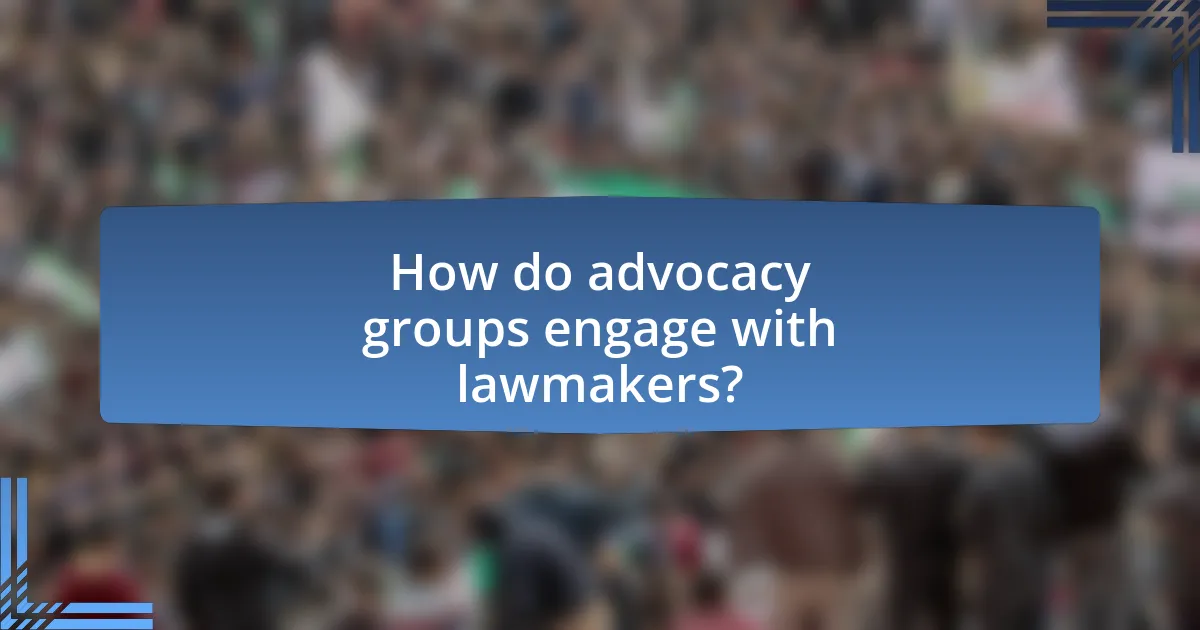
How do advocacy groups engage with lawmakers?
Advocacy groups engage with lawmakers through direct lobbying, grassroots mobilization, and strategic communication. These groups often employ lobbyists to meet with legislators, present research, and advocate for specific policies related to abortion legislation. For instance, organizations like Planned Parenthood and the National Right to Life Committee actively lobby Congress to influence decisions on reproductive rights. Additionally, advocacy groups mobilize their supporters to contact lawmakers, demonstrating public support or opposition to legislation, which can significantly impact lawmakers’ decisions. Research shows that grassroots campaigns can lead to increased legislative attention on specific issues, as seen in various abortion-related legislative efforts across the United States.
What methods do advocacy groups use to lobby for abortion legislation?
Advocacy groups use various methods to lobby for abortion legislation, including grassroots mobilization, direct lobbying of legislators, public awareness campaigns, and coalition-building. Grassroots mobilization involves organizing community members to participate in rallies, phone banks, and letter-writing campaigns to demonstrate public support for abortion rights. Direct lobbying entails meeting with lawmakers to present research, personal stories, and data that highlight the importance of reproductive rights, influencing policy decisions. Public awareness campaigns utilize media, social media, and educational initiatives to inform the public about abortion issues and to sway public opinion. Coalition-building involves partnering with other organizations to strengthen their lobbying efforts, pooling resources, and amplifying their collective voice to advocate for legislative change. These methods have been effective in shaping abortion legislation, as evidenced by the passage of laws in various states that reflect the priorities of these advocacy groups.
How do advocacy groups build relationships with policymakers?
Advocacy groups build relationships with policymakers through strategic communication, grassroots mobilization, and providing valuable information. These groups often engage in direct lobbying, where they meet with legislators to discuss specific issues and advocate for policy changes. Additionally, they mobilize their supporters to contact policymakers, creating a sense of urgency and demonstrating public support for their causes. Advocacy groups also conduct research and disseminate data that highlight the importance of their issues, which helps to inform and persuade policymakers. For instance, studies have shown that well-organized advocacy efforts can significantly influence legislative outcomes, as seen in various abortion-related policies where advocacy groups have successfully swayed public opinion and legislative action.
What role do campaign contributions play in lobbying efforts?
Campaign contributions significantly enhance lobbying efforts by providing financial resources that enable advocacy groups to influence policymakers. These contributions can secure access to legislators, facilitate communication, and promote specific agendas, particularly in contentious areas like abortion legislation. For instance, a study by the Center for Responsive Politics found that in the 2020 election cycle, over $1.5 billion was spent on campaign contributions related to abortion issues, illustrating the financial stakes involved. This financial backing often translates into increased lobbying activity, as organizations leverage their contributions to gain favor and push for legislative outcomes aligned with their interests.
How do advocacy groups utilize legal strategies in their efforts?
Advocacy groups utilize legal strategies by engaging in litigation, lobbying for legislative changes, and filing amicus curiae briefs to influence court decisions. These groups often initiate lawsuits to challenge restrictive abortion laws, aiming to set legal precedents that protect reproductive rights. For example, the Center for Reproductive Rights has successfully litigated cases like Whole Woman’s Health v. Hellerstedt, which struck down Texas laws imposing unnecessary restrictions on abortion providers. Additionally, advocacy groups lobby lawmakers to enact or repeal legislation that affects abortion access, leveraging legal frameworks to support their positions. By filing amicus curiae briefs, these organizations provide courts with expert opinions and data to bolster their arguments, thereby shaping judicial outcomes related to abortion legislation.
What are some landmark legal cases influenced by advocacy groups?
Landmark legal cases influenced by advocacy groups include Roe v. Wade (1973), Planned Parenthood v. Casey (1992), and Whole Woman’s Health v. Hellerstedt (2016). Roe v. Wade established a woman’s legal right to have an abortion, significantly shaped by the advocacy of pro-choice organizations. Planned Parenthood v. Casey reaffirmed Roe’s core holding while allowing states to impose certain restrictions, influenced by both pro-choice and anti-abortion advocacy groups. Whole Woman’s Health v. Hellerstedt struck down Texas regulations that imposed undue burdens on women seeking abortions, reflecting the efforts of advocacy groups to protect access to reproductive health services. These cases demonstrate the substantial impact advocacy groups have had on abortion legislation and women’s rights in the United States.
How do advocacy groups participate in litigation related to abortion laws?
Advocacy groups participate in litigation related to abortion laws by filing lawsuits, submitting amicus curiae briefs, and providing legal support to plaintiffs. These organizations often challenge restrictive abortion laws in court, arguing that such laws violate constitutional rights, such as the right to privacy established in Roe v. Wade. For instance, in cases like Whole Woman’s Health v. Hellerstedt, advocacy groups played a crucial role in presenting evidence and legal arguments that highlighted the negative impact of Texas’s abortion regulations on women’s health. Their involvement not only amplifies the voices of affected individuals but also helps shape legal precedents that influence future abortion legislation.
What challenges do advocacy groups face in influencing legislation?
Advocacy groups face significant challenges in influencing legislation, including limited financial resources, political opposition, and public apathy. Limited funding restricts their ability to conduct extensive campaigns or hire expert lobbyists, which diminishes their impact on lawmakers. Political opposition arises when legislators or political parties have conflicting agendas, making it difficult for advocacy groups to gain traction for their causes. Additionally, public apathy can hinder advocacy efforts, as a lack of widespread support reduces pressure on legislators to act. These challenges are evident in the context of abortion legislation, where advocacy groups often encounter strong opposition from well-funded organizations that promote restrictive policies.
How do political opposition and societal attitudes impact advocacy efforts?
Political opposition and societal attitudes significantly influence advocacy efforts by shaping the environment in which these groups operate. Advocacy groups often face challenges when political leaders or parties oppose their goals, as this can lead to legislative barriers, reduced funding, and limited public support. For instance, in the context of abortion legislation, states with strong political opposition to abortion rights have enacted restrictive laws, making it difficult for advocacy groups to promote reproductive rights effectively. Additionally, societal attitudes play a crucial role; when public opinion is largely against a particular issue, advocacy efforts may struggle to gain traction, as seen in regions where anti-abortion sentiments prevail. Research indicates that advocacy success is often contingent upon aligning strategies with prevailing societal views, as demonstrated by the shifts in public opinion that have influenced legislative changes in various states.
What are the limitations of advocacy group influence on legislation?
Advocacy groups face several limitations in influencing legislation, primarily due to competing interests, regulatory frameworks, and public opinion. Competing interests from other advocacy groups or political entities can dilute their impact, as seen in the contentious debates surrounding abortion legislation where pro-choice and pro-life groups exert opposing pressures. Additionally, legislative processes often involve complex rules and procedures that can hinder the direct influence of advocacy groups, such as the requirement for a supermajority in certain votes. Public opinion also plays a crucial role; if the majority of constituents oppose the advocacy group’s stance, legislators may be less inclined to support their initiatives, as evidenced by fluctuating public attitudes toward abortion rights over the years. These factors collectively limit the effectiveness of advocacy groups in shaping legislation.
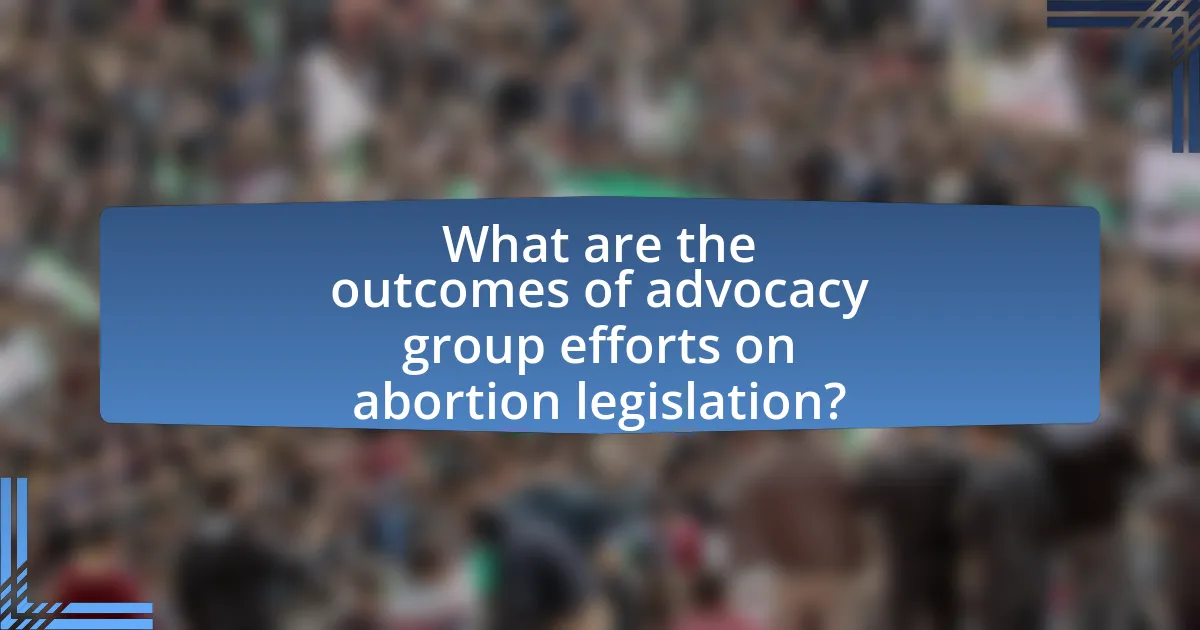
What are the outcomes of advocacy group efforts on abortion legislation?
Advocacy group efforts on abortion legislation have led to significant changes in laws and public policy regarding reproductive rights. For instance, organizations such as Planned Parenthood and the National Abortion Federation have successfully influenced legislation by mobilizing public opinion, lobbying lawmakers, and providing legal challenges against restrictive laws. In 2021, advocacy groups played a crucial role in the defeat of several anti-abortion bills in states like Texas and Florida, demonstrating their effectiveness in shaping legislative outcomes. Additionally, research indicates that states with active advocacy groups tend to have more comprehensive reproductive health policies, highlighting the direct impact of these organizations on legislative processes.
How have advocacy groups successfully shaped abortion laws in various states?
Advocacy groups have successfully shaped abortion laws in various states by mobilizing public opinion, influencing legislation, and providing legal challenges. For instance, organizations like Planned Parenthood and the American Civil Liberties Union have launched campaigns that raise awareness about reproductive rights, leading to increased public support for abortion access. In states such as Texas and Alabama, these groups have actively lobbied against restrictive laws, resulting in court cases that challenge the constitutionality of such measures. The 2016 Supreme Court case Whole Woman’s Health v. Hellerstedt, which was influenced by advocacy efforts, struck down Texas regulations that imposed unnecessary requirements on abortion clinics, demonstrating the tangible impact of these organizations on state laws.
What specific legislative changes can be attributed to advocacy group efforts?
Specific legislative changes attributed to advocacy group efforts include the passage of the Women’s Health Protection Act, which aimed to protect the right to access abortion services. Advocacy groups such as Planned Parenthood and the Center for Reproductive Rights mobilized public support and lobbied Congress, highlighting the need for federal protections in response to state-level restrictions. Additionally, the repeal of the Hyde Amendment in certain states, which restricted federal funding for abortions, was influenced by advocacy efforts that emphasized reproductive justice and healthcare equity. These changes reflect the direct impact of organized advocacy on shaping abortion legislation in the United States.
How do these changes reflect the goals of the advocacy groups involved?
The changes in abortion legislation reflect the goals of advocacy groups by aligning legal frameworks with their objectives for reproductive rights and access to healthcare. For instance, organizations like Planned Parenthood advocate for policies that expand access to abortion services, which is evident in recent legislative efforts that aim to protect and enhance reproductive rights. These advocacy groups utilize data showing that increased access to abortion services leads to better health outcomes for women, thereby reinforcing their mission to ensure safe and legal abortion options.
What unintended consequences can arise from advocacy group actions?
Unintended consequences from advocacy group actions can include polarization of public opinion and backlash against the issues they support. For instance, when advocacy groups push for stricter abortion laws, they may inadvertently galvanize opposition movements, leading to increased activism from pro-choice organizations. This dynamic can create a more divided societal landscape, as seen in the United States where advocacy efforts have intensified debates and protests surrounding abortion rights. Additionally, advocacy actions can sometimes result in legislative pushback, where lawmakers may introduce countermeasures that further entrench the status quo rather than promote meaningful change. Such outcomes illustrate how advocacy efforts can lead to complexities that diverge from their original goals.
How can advocacy efforts lead to backlash or increased polarization?
Advocacy efforts can lead to backlash or increased polarization by intensifying existing divisions within society. When advocacy groups promote specific agendas, such as those related to abortion legislation, they often provoke strong emotional responses from opposing factions. For instance, a study by the Pew Research Center found that advocacy on contentious issues like abortion can deepen ideological divides, as individuals align more closely with their respective viewpoints and become less open to compromise. This polarization is further exacerbated by social media, where echo chambers amplify extreme perspectives and diminish dialogue, leading to a cycle of conflict rather than consensus.
What are the long-term effects of advocacy group influence on abortion rights?
Advocacy group influence on abortion rights leads to significant long-term effects, including the shaping of public policy, changes in societal attitudes, and the mobilization of political action. These groups, such as Planned Parenthood and the National Right to Life Committee, actively campaign for or against legislation, which can result in the enactment or repeal of laws governing abortion access. For instance, the 1973 Roe v. Wade decision was heavily influenced by advocacy efforts, establishing a legal precedent that has been challenged and defended through ongoing advocacy. Additionally, research indicates that sustained advocacy efforts can shift public opinion over time, as seen in the increasing acceptance of abortion rights in various demographics. This influence often translates into electoral outcomes, where candidates’ positions on abortion can determine their success, further entrenching the advocacy group’s goals within the political landscape.
What best practices can advocacy groups adopt to enhance their effectiveness?
Advocacy groups can enhance their effectiveness by employing strategic coalition-building, which allows them to pool resources, share expertise, and amplify their voices. Research indicates that coalitions can increase the likelihood of achieving policy goals; for instance, the National Network of Abortion Funds successfully mobilized various organizations to advocate for reproductive rights, resulting in increased funding and support for abortion access. Additionally, advocacy groups should utilize data-driven campaigns to inform their strategies, as evidence-based approaches have been shown to resonate more with policymakers and the public. A study by the Center for American Progress highlights that campaigns grounded in solid data can lead to more persuasive messaging and greater impact on legislative outcomes. Finally, continuous engagement with constituents through grassroots mobilization fosters a sense of community and urgency, which is crucial for sustaining momentum in advocacy efforts.
How can advocacy groups better engage with diverse communities?
Advocacy groups can better engage with diverse communities by implementing culturally relevant outreach strategies. These strategies include conducting community needs assessments to understand specific cultural contexts and barriers, which allows advocacy groups to tailor their messaging and services effectively. For instance, research from the American Psychological Association highlights that culturally competent communication increases trust and participation among marginalized groups. Additionally, forming partnerships with local leaders and organizations can enhance credibility and facilitate access to diverse populations, as evidenced by successful initiatives in public health campaigns that utilized community-based approaches.
What strategies can improve collaboration among different advocacy organizations?
Improving collaboration among different advocacy organizations can be achieved through establishing clear communication channels, shared goals, and joint initiatives. Clear communication ensures that all parties are informed and aligned, while shared goals foster a sense of unity and purpose. Joint initiatives, such as collaborative campaigns or events, can leverage the strengths of each organization, maximizing impact. Research indicates that organizations that engage in collaborative efforts are more effective in influencing policy outcomes, as seen in various successful advocacy coalitions that have shaped legislation.
